AUDI A4 AVANT 2008 Owners Manual
Manufacturer: AUDI, Model Year: 2008, Model line: A4 AVANT, Model: AUDI A4 AVANT 2008Pages: 368, PDF Size: 46.19 MB
Page 271 of 368
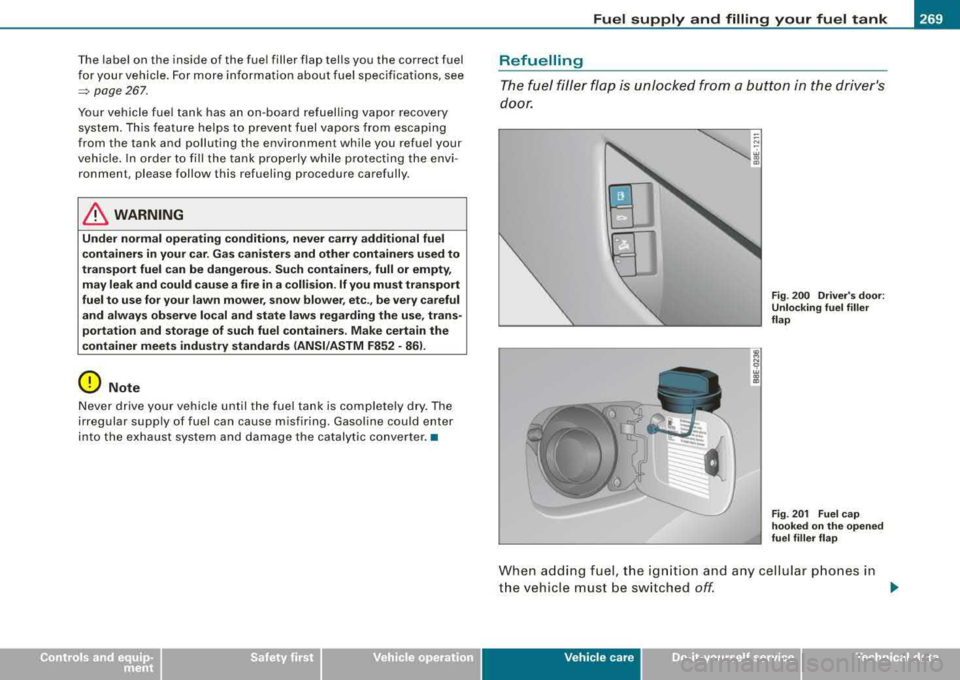
The label on the inside of the fuel filler flap tells you the correct fuel
for your vehicle . F o r m ore information abou t fuel specif ications, see
=> page 267 .
Your vehicle fue l tank has an on -board refuelling vapor recovery
system. Th is feature helps to prevent fuel vapors from escapin g
from the tank and polluting the environment wh ile you refue l your
veh ic le . I n order to fi ll the ta nk properly whi le protect ing the envi
ronment, please follow this refueling procedure care fully .
& WARNING
Under normal operating conditions , never carry additional fuel
container s in your car. Gas canisters and other containers used to
transport fuel can be dangerous . Such conta iners , full or empty ,
may leak and could cause a fire in a collision . If you must transport
fuel to use for your lawn mower , snow blower , etc. , be very c areful
and always ob serve local and state law s regarding the u se , trans
port ation and storage of su ch fuel containers . Make certain the
container meets industry standards (ANSI/ASTM F852 -86 1.
0 Note
Never drive you r ve hicle unti l the fue l tank is comp le tely dry . The
irregular supply of fuel can cause misfiring . Gasoline cou ld enter
into the exha ust system and damage the catalytic c onverter. •
Fuel supply and fill ing your fuel tank
Refuelling
The fuel filler fl ap is unl ocked f rom a button in the dri ver's
door.
Fig . 2 00 Driv er's door :
Unl ocking fuel filler
flap
Fig . 201 Fu el c ap
hooked on the opened
fu el
fill er flap
When add ing fuel, the ign ition and an y cellular p hones in
t h e vehicle must be sw itched
off. .,.
Ve hic le care irechnical data
Page 272 of 368
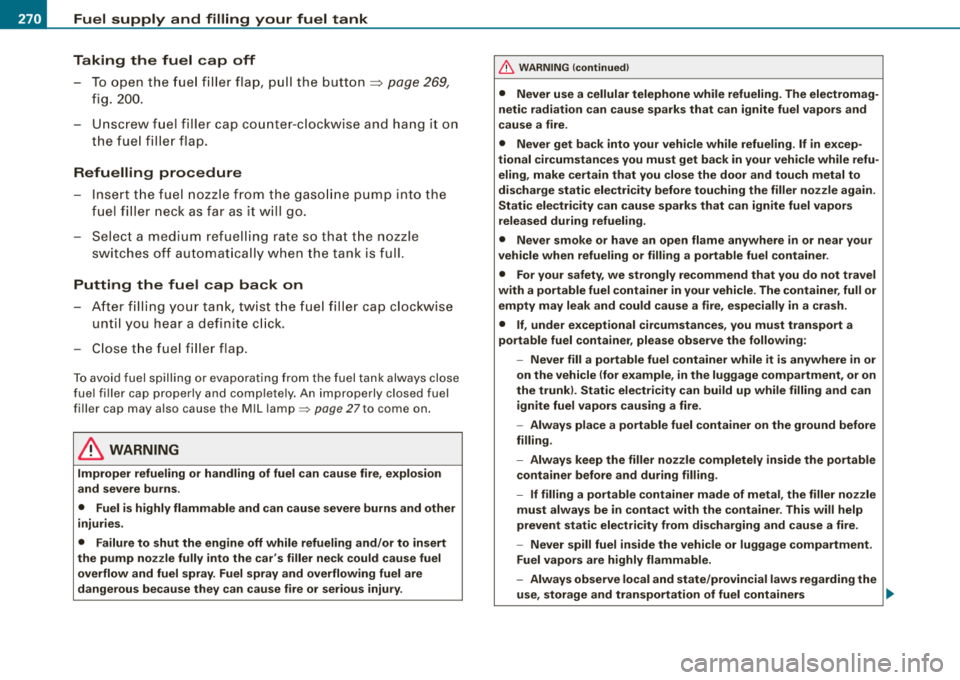
Fuel supply and filling your fuel tank
Taking the fuel cap off
- To open the fuel filler flap, pull the button~ page 269,
fig. 200.
- Unscrew fuel filler cap counter-clockwise and hang it on the fuel filler flap.
Refuelling procedure
- Insert the fuel nozzle from the gasoline pump into the
fuel filler neck as far as it will go.
- Select a medium refuelling rate so that the nozzle
switches off automatically when the tank is full.
Putting the fuel cap back on
- After filling your tank, twist the fuel filler cap clockwise
until you hear a definite click.
- Close the fuel filler flap.
To avoid fuel spilling or evaporating from the fuel tank always close
fuel filler cap properly and completely. An improperly closed fuel
filler cap may also cause the MIL lamp => page 27to come on.
& WARNING
Improper refueling or handling of fuel can cause fire, explosion
and severe burns .
• Fuel is highly flammable and can cause severe burns and other
injuries.
• Failure to shut the engine off while refueling and/or to insert
the pump nozzle fully into the car's filler neck could cause fuel
overflow and fuel spray. Fuel spray and overflowing fuel are
dangerous because they can cause fire or serious injury.
& WARNING (continued)
• Never use a cellular telephone while refueling. The electromag
netic radiation can cause sparks that can ignite fuel vapors and
cause a fire .
• Never get back into your vehicle while refueling. If in excep
tional circumstances you must get back in your vehicle while refu
eling, make certain that you close the door and touch metal to
discharge static electricity before touching the filler nozzle again .
Static electricity can cause sparks that can ignite fuel vapors
released during refueling .
• Never smoke or have an open flame anywhere in or near your
vehicle when refueling or filling a portable fuel container.
• For your safety, we strongly recommend that you do not travel
with a portable fuel container in your vehicle. The container, full or
empty may leak and could cause a fire, especially in a crash.
• If, under exceptional circumstances, you must transport a
portable fuel container, please observe the following:
- Never fill a portable fuel container while it is anywhere in or
on the vehicle (for example, in the luggage compartment, or on
the trunk). Static electricity can build up while filling and can
ignite fuel vapors causing a fire.
- Always place a portable fuel container on the ground before
filling.
- Always keep the filler nozzle completely inside the portable container before and during filling.
- If filling a portable container made of metal, the filler nozzle must always be in contact with the container. This will help
prevent static electricity from discharging and cause a fire.
- Never spill fuel inside the vehicle or luggage compartment .
Fuel vapors are highly flammable.
- Always observe local and state/provincial laws regarding the
use, storage and transportation of fuel containers
~
Page 273 of 368
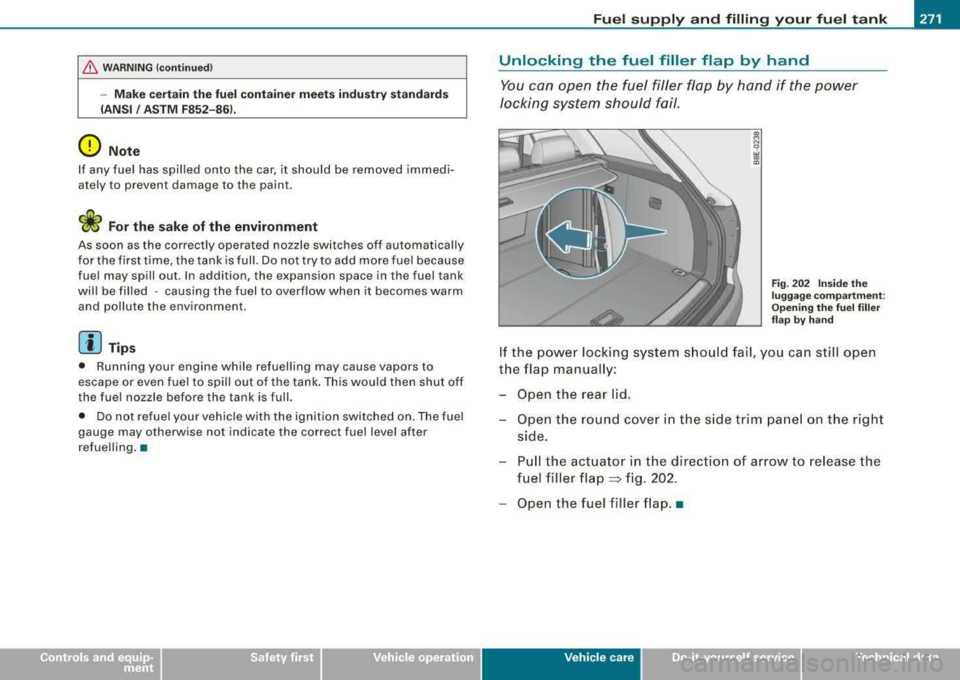
Fuel supply and filling your fuel tank ------------ -=--=---=-----:::,.......c._ _ __,
/b, WARNING (continued)
-Make certain the fuel container meets industry standards
(ANSI / ASTM F852-861.
0 Note
If any fuel has spilled onto the car, it should be removed immedi
ately to prevent damage to the paint.
ffi For the sake of the environment
As soon as the correctly operated no zzle switches off automatically
for the first time, the tank is full. Do not try to add more fuel because
fu el may spill out . In addition, the expansion space in the fuel tank
will be filled
-causing the fuel to overflow when it becomes warm
and pollute the environment.
[ i] Tips
• Running your engine while refuelling may cause vapors to
escape or even fuel to spill out of the tank. This would then shut off
the fuel nozzle before the tank is full.
• Do not refuel your vehicle with the ignition switched on. The fuel
gauge may o therwise not indicate the correc t fuel level after
refuelling. •
Unlocking the fuel filler f lap by hand
You can open the fuel filler flap by hand if the power
locking system should fail.
Fig . 202 Inside the
luggage compartment:
Opening the fuel filler
flap by hand
If the power locking system should fail, you can still open
the flap manually:
- Open the rear lid.
- Open the round cover in the side trim panel on the right
side.
- Pull the actuator in the direction of arrow to release the
fuel filler flap
=> fig. 202.
- Open the fuel filler flap. •
Vehic le care irechnical data
Page 274 of 368

-Checking and filling Pll':f..._--=--=--------------
Checking and filling
Engine hood
Releasing the engine hood
The engine hood is released from inside the vehicle.
Fig. 203 Driver's side
footwell: engine hood
release lever
- Pull the release lever on the left under the instrument
panel=> fig. 203 in the direction of the arrow.
The hood pops up slightly under spring pressure. •
Opening the engine hood
Fig. 204 Release lever
under the hood
Before opening the engine hood, make sure that the wind
shield wipers are flat against the windshield. Otherwise,
they could damage the paint on the hood.
Lift the hood
slightly=> ,&.
- Pull the release under the hood => fig. 204. This releases
the catch.
- Open the hood all the way.
The hood is kept in the open position by a gas strut.
& WARNING
Hot engine coolant can burn you.
• To reduce the risk of being burned, never open the hood
if you
see or hear steam or coolant escaping from the engine compart-.,..
Page 275 of 368

Checking and filling -
-----------------------------==--------=--
& WARNING (continued)
ment. Wait until no steam or coolant can be seen or heard before
carefully opening the hood.
•
Closing the engine hood
- Pull the hood down until the pressure from the strut is
reduced.
- Let the hood
drop down and latch in place. Do not try to
push
it shut; it may fail to engage =:>& .
& WARNING
A hood that is not completely latched could fly up and block your
view while driving.
• When you close the engine hood, check it to make sure the
safety catch has properly engaged. The hood should be flush with
the surrounding vehicle body parts.
• If you notice while driving that the hood is not secured prop
erly, stop at once and close it. •
Working in the engine compartment
Be especially careful whenever you work in the engine
compartment.
Whenever you must perform any work in the engine compartment,
for example checking and filling different fluids, there is a risk of
injury, burns and accidents. To prevent personal injury always
observe the following WARNINGS . The engine compartment of any
vehicle is a hazardous area
=> & .
• I I • • I
& WARNING
To help avoid injury, before you check anything under the hood:
• Turn off the engine.
• Remove the ignition key .
• Apply the parking brake.
• Move selector lever of automatic transmission to
"P" (Park);
put manual transmission in Neutral.
• Always let the engine cool down. Hot components will burn
skin on contact.
• To reduce the risk of being burned, never open the hood if you
see or hear steam or coolant escaping from the engine compart
ment. Wait until no steam or coolant can be seen or heard before
carefully opening the hood.
• Keep children away from the engine compartment.
• Never spill fluids on hot engine components. They can cause a
fire.
• Never touch the radiator fan. The auxiliary electric fan is
temperature controlled and can switch on suddenly.
• Never open the coolant reservoir cap when the engine is still
warm . The coolant system is pressurized and hot coolant could
spray out.
• Protect your face, hands and arm from steam or hot engine
coolant by placing a thick rag over the cap when you open the
coolant reservoir .
• If work on the fuel system or the electrical system is necessary: -Always disconnect the battery.
- Never smoke or work near heaters or open flames. Fluids in
the engine compartment could start a fire .
- Keep an approved fire extinguisher immediately available.
• To avoid electrical shock and personal injury while the engine
is running or being started, never touch:
- Ignition cables
.,_
Vehicle care
Page 276 of 368

lffll...__C_ h_ e_c _k _ i_n ..::g ,_ a_n_ d_ f_il _li _n....: g==-- --------------------------------------------
& WARNING (continued )
-Other components of the high voltage electronic ignition
system .
• If you must perform a che ck or repair with the engine running:
- Fir st, fully apply the parking brake , move selector lever of
automatic transmission to
" P " (Park ); put manual transmission
in Neutral.
- Alway s use extreme caution to prevent clothing , jewelry , or
long hair from getting caught in the radiator f an, V -belts or
other moving part s, or from contacting hot parts. Tie ba ck hair
before starting , and we ar no clothing that will hang or droop
into the engine.
• Min imize e xposure to emission and chemical hazards
=> & .
& WARNING
California Proposition 65 Warning :
• Engine exhaust , some of its constituents , and certa in vehicle
c omponents contain or emit chemicals known to the State of Cali
fornia to cause cancer and birth defects and reproductive harm . In
addition , certain fluids contained in vehicles and certain products
of component wear contain or emit chemical s known to the State
of California to cause cancer and birth defects or other reprodu c
tive harm.
• Battery posts, terminal s and related accessories contain lead
and lead compounds , chemicals known to the State of California
to cause cancer and reproductive harms . Wash hands after
handling.
0 Note
When a dding f luids, always make sur e tha t they are poured i nto the
prop er container or filler opening, otherwise serious damage to
ve hicle syste ms wi ll occur .
ffi For the sake of the environment
To detect leaks i n time, inspect the veh icle floor pan from unde r
neath regularly. If you see spots from oil or other vehicle fluids, have
your veh ic le i nspected by a n authori zed Audi dealer. •
Engine compartment
Applies to v ehic les: with 2 .0 I tur bo, 4-cy linder -e n gi ne
2 .0 I, 4-cy linder turbo engine (200 hp)
T hese are th e mo st impo rtant items that you ca n check .
Fig . 205 Engine comp artment : 2 .0 I , 4-cylind er turbo
G) Battery ... ..... .. ... .... ... ...... ... .. .. ... .. .
0 Engine oil fil le r cap (
© Engine oil dipstick ( orange) .. .... .. .... .... ... .. .
285
2 78
2 8 4
277 ....
Page 277 of 368

Checking and filling -
------------ ----=---a::;;._...a
©
©
(i)
Coolant expansion tank ( ... L) ...... ... .. ..... .. ... .
Windshield/headlight washer container
( 0 ) ...... . .
Power steering reservoir (green cap)
& WARNING
Before you check anything in the engine compartment, always
read and heed all WARNINGS
=> & in "Working in the engine
compartment" on
page 273. •
Applies to vehicles: with 6 -cy lin d er engine
3.2 liter , 6-cylinder engine (255 hp)
281
291
241
These are the most important items that you can check.
Fig . 206 Engine compartment: 3 .2 liter , 6-cylinder
CD
0
©
Battery .. ............... ... .. ...... .... ...... .
Brake fluid reservoir (
... ) . .. ... ... .... .... ...... .
Coo lant expansion tank
(J _)
285
284
281
©
©
©
(i)
Engine oil filler cap (
Windshield/headlight washer container
( O ) ... .... .
Power steering reservoir (green cap)
& WARNING
Before you check anything in the engine compartment , always
read and heed all WARNINGS
=> & in "Working in the engine
compartment" on
page 273. •
Engine oil
Engine oil specifications
278
277
291
241
The engine oil used in your Audi needs the right kind of
oil.
The engine in your Audi is a sophisticated powerplant that was built
to exacting specifications . This engine needs the right kind of
engine oil that meets specifications regarding quality and viscosity
so that it can run smoothly and re liably . Choosing the right oil and
changing oil within the time and mileage intervals printed in your
vehicle's Maintenance
& Warranty booklet matters a lot more today
than it did years ago. Audi has developed a special quality standard
f or engine oil that wil l help assure that your vehicle's engine wi ll get
the lubrication it needs for proper operation .
Modern engine lubrication has taken a quantum leap in the last few
years. Many synthetic oils available today provide better engine
lubrication that can outlast traditional petroleum-based oils,
making them a smart choice for use throughout the life of your Audi .
Whether you use synthetic or petroleum -based engine oil, the oil
that you use must conform to Audi's oi l quality standard VW 502 00
to help keep your vehicle 's engine running smoothly and help
.,_
Ve hic le care Technical data
Page 278 of 368
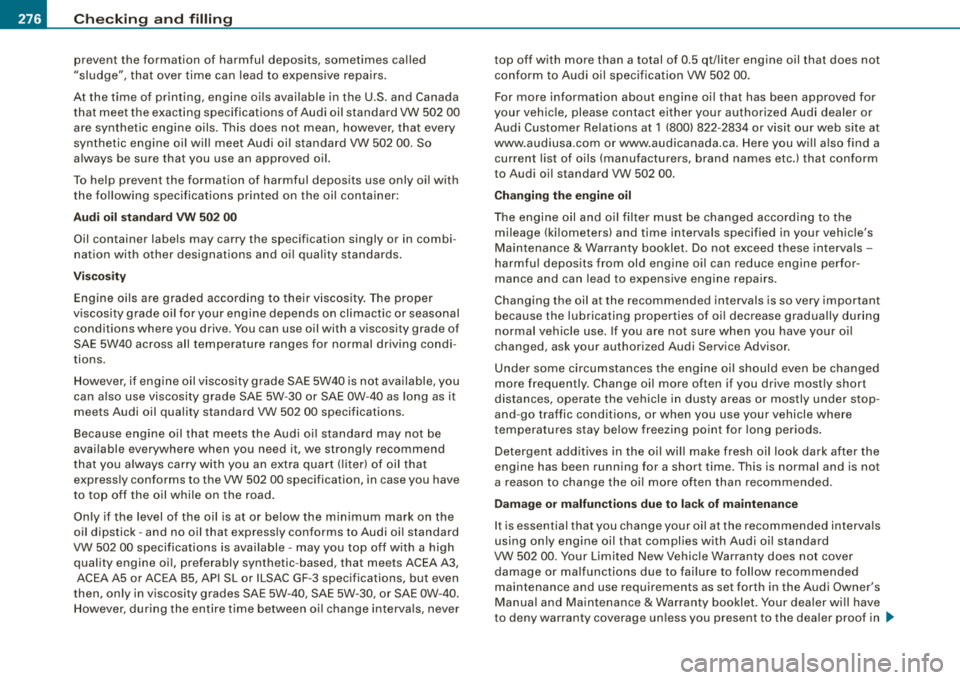
___ C_ h_ e_c _k _ i_n ~g _ a_n_ d_ f_il _li _n_ g~--------------------------------------------
prevent the formation of harmful deposits, sometimes called
"sludge", that over time can lead to expensive repairs.
At the time of printing, engine oils available in the U .S . and Canada
that meet the exacting specifications of Audi oil standard VW 502 00
are synthetic engine oils. This does not mean, however, that every
synthetic engine oil will meet Audi oil standard VW 502 00. So
always be sure that you use an approved oil.
To help prevent the formation of harmful deposits use only oil with
the following specifications printed on the oil container:
Audi oil standard VW 502 00
Oil container labels may carry the specification singly or in combi
nation with other designations and oil quality standards.
Viscosity
Engine oils are graded according to their viscosity. The proper
viscosity grade oil for your engine depends on climactic or seasonal
condi tions where you drive. You can use oil wi th a viscosity grade of
SAE 5W40 across all temperature ranges for normal driving condi
tions .
However, if engine oil viscosity grade SAE 5W40 is not available, you
can also use viscosity grade SAE 5W-30 or SAE 0W-40 as long as it
meets Audi oil quality standard VW 502 00 specifications.
Because engine oil that meets the Audi oil standard may not be
available everywhere when you need it, we strongly recommend
that you always carry with you an extra quart (liter) of oil that
expressly conforms to the VW 502 00 specification, in case you have
to top off the oil while on the road.
Only if the level of the oil is at or below the minimum mark on the
oil dipstick -and no oil that expressly conforms to Audi oil standard
VW 502 00 specifications is available - may you top off with a high
quality engine oil, preferably synthetic -based , that meets ACEA A3,
ACEA A5 or ACEA B5, API SL or ILSAC GF -3 specifications, but even
then, only in viscosity grades SAE 5W -40, SAE 5W -30, or SAE 0W -40 .
However, during the entire time between oil change intervals, never top off with more than a total of 0
.5 qt/liter engine oil that does not
conform to Audi oil specification VW 502 00.
For more information about engine oil that has been approved for
your vehicle, please contact either your authorized Audi dealer or
Audi Customer Relations at 1 (800) 822-2834 or visit our web site at
www.audiusa.com or www.audicanada.ca. Here you will also find a
current list of oils (manufacturers, brand names etc.) that conform
to Audi oil standard VW 502 00.
Changing the engine oil
The engine oil and oil filter must be changed according to the
mileage (kilometers) and time intervals specified in your vehicle's
Maintenance & Warranty booklet. Do not exceed these intervals -
harmful deposits from old engine oil can reduce engine perfor
mance and can lead to expensive engine repairs.
Changing the oil at the recommended intervals is so very important
because the lubricating properties of oil decrease gradually during
normal vehicle use. If you are not sure when you have your oil
changed, ask your authorized Audi Service Advisor.
Under some circumstances the engine oil should even be changed
more frequently . Change oil more often if you drive mostly short
distances, operate the vehicle in dusty areas or mostly under stop
and-go traffic conditions, or when you use your vehicle where
temperatures stay below freezing point for long periods.
Detergent additives in the oil will make fresh oil look dark after the
engine has been running for a short time. This is normal and is not
a reason to change the oil more often than recommended.
Damage or malfunctions due to lack of maintenance
It is essential that you change your oil at the recommended intervals
using only engine oil that complies with Audi oil standard
VW 502 00. Your Limited New Vehicle Warranty does not cover
damage or malfunctions due to failure to follow recommended
maintenance and use requirements as set forth in the Audi Owner's
Manual and Maintenance & Warranty booklet. Your dealer will have
to deny warranty coverage unless you present to the dealer proof in
.,_
Page 279 of 368

Checkin g a nd fillin g --------------~~~-
the form of Service or Repair Orders that all scheduled maintenance
was performed in a t ime ly manner .•
Engine oil consumption
The engine in your vehicle depends on an adequate
amount of oil to lubricate and cool all of its moving parts.
In order to prov ide effect ive lubrication and cool ing of in ternal
engine components, all internal combustion engines consume a
certain amount of o il. Oil consumption varies from engine to engine
and may change significantly over the life of the engine . Typically,
eng ines wi th a specified break -in period
(see ~ page 243) consume
more oil during the break -in period than they consume after oi l
consumption has stabi lized .
Under norma l condit ions, the rate of o il consumption depends on
the quality and viscosity of the oil, the RPM (revo lutions per minute)
at whic h the engine is operated, t he amb ient te mperature and road
conditions. Further factors are the amount of oil dilution from water
condensatio n or fuel residue and t he oxidation level of the o il. As
any engine is subject to wear as mileage builds up, the oil consump
t ion may increase over time until rep laceme nt of worn components
may become necessary .
With all these variables coming into play, no standard rate of oil consu mption can be estab lished or specified. T here is no a lternative
to regu lar and frequent checking of the oil level, see
Note .
If the yellow eng ine o il level warni ng symbol in the instrument
cluster ~ lights up, you should check the oil level as soon as
possible
with the oil dipstick ~ page 277 . Top off the o il at your
earl iest
convenience~ page 278.
& WARNING
Bef ore you che ck anything in the eng ine comp artment , alway s
read and heed all WARNINGS
~ & in "Working in the engine
c ompartment " on
page 27 3.
0 Note
Driving with an insuff ic ient oil level is l ikely to cause severe damage
to the engine.
[ i ] Tip s
• The oil pres sure warning displ ay "e:7: is n ot an indi cator of the oil
level . Do not rel y on it. Instead, check the oil level in your engine at
regular inter vals, preferably ea ch time you refuel , and al way s before
going on a long trip.
• If you have the impression your engine consumes excessive
amounts of oi l, we reco mmend that you consult your Audi dealer to
have the cause of your concern properly diagnosed . Keep in mind
that t he accurate measurement of oil consumptio n requ ires great
care and may take some time. Your Audi dealer has instructions
about how t o measure oil cons umpt ion accurately. •
Checking the engine oil level
Vehicle care
Fig. 2 07 Illu strati on of
prin ciple 1: M ark ers on
oil dip sti ck ...
Page 280 of 368
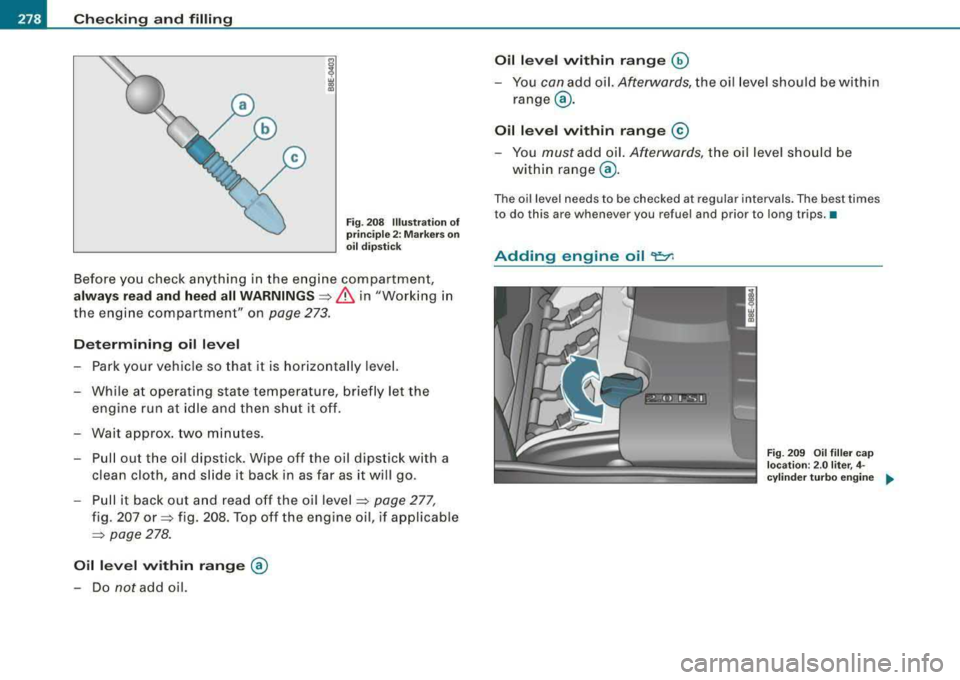
llffll...__C_ h_ e_c _k _ i_n ..::g ,_ a_n_ d_ f_il _li _n....: g==---------------------------------------------
Fig. 208 Illustra tion o f
principle 2: Markers on
oil dipstick
Before you check anything in the engine compartment,
always read and heed all WARNINGS => & in "Working in
the engine compartment" on
page 273.
Determining oil level
-Park your vehicle so that it is horizontally level.
- While at operating state temperature, briefly let the
engine run at idle and then shut
it off.
- Wait approx. two minutes.
- Pull out the oil dipstick . Wipe off the oil dipstick with a
clean cloth, and s lide it back in as far as it will go.
- Pull it back out and read off the oil level
=> page 277,
fig. 207 or=> fig . 208. Top off the engine oil, if applicable
=> page 278.
Oil level within range @
-Do not add oil.
Oil level within range ~
You can add oil. Afterwards, the oil level should be within
range @.
Oil level within range ©
-You must add oil. Afterwards, the oil level should be
within range @.
The oil level needs to be checked at regular intervals. The best times
to do this are whenever you refuel and prior to long trips. •
Adding engine oil 'l:::7:
Fig. 209 Oil filler cap
locat ion: 2.0 liter , 4-
cylinder turbo engine
...